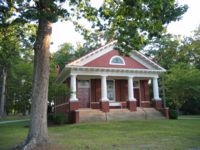

|
The following historical sketch of Red House Presbyterian Church, located near Semora in northeastern Caswell County, North Carolina is from When the Past Refused to Die: A History of Caswell County North Carolina 1777-1977, William S. Powell (1977):
|
Red House Church near Semora may have existed as early as 1755. It was known first as Middle Hico, but the name was changed to Red House about 1806 as that was the name by which the community was generally known. The name came from a noted inn nearby that was painted red. It was a popular stopping place between Hillsborough and the Virginia line. The Rev. Hugh McAden served the congregation here from 1768 until his death in 1781, and he is buried in the churchyard. He died a short while before British troops under General Charles Cornwallis invaded the area, and his grave is said by tradition to have been opened by his troops in search of gold or other valuables. British troops are also credited with the destruction of his journal, books, and other records and with extensive damage to the church and family property. The first church is said to have been built in 1756, the second in 1806, the third in 1809 (presumably after a fire destroyed the recently built structure), and the present one in 1913. The 1809 church was remembered as "a quaint wooden structure. It faced west, and inside the pulpit stood between the two front doors by which the congregation entered the church." This meant that late-comers could not slip in unobserved and take a back seat--they entered the front and had to take seats in the sight of those already present. It was also remembered that there was no balcony for slaves as was the case elsewhere; instead there were seats to one side for the blacks who attended with their masters. The pews were said to have been made by Thomas Day in Milton, and when the present church was occupied they were given to Gilead Presbyterian Church.
Hugh McAden was born in Pennsylvania of Scotch-Irish parentage and he was educated at Nassau Hall, now Princeton University. He was a diligent missionary and pastor and the Red House community became a cultured center because of his presence. The Murphey family also lived nearby and for many years an academy was conducted near the church.